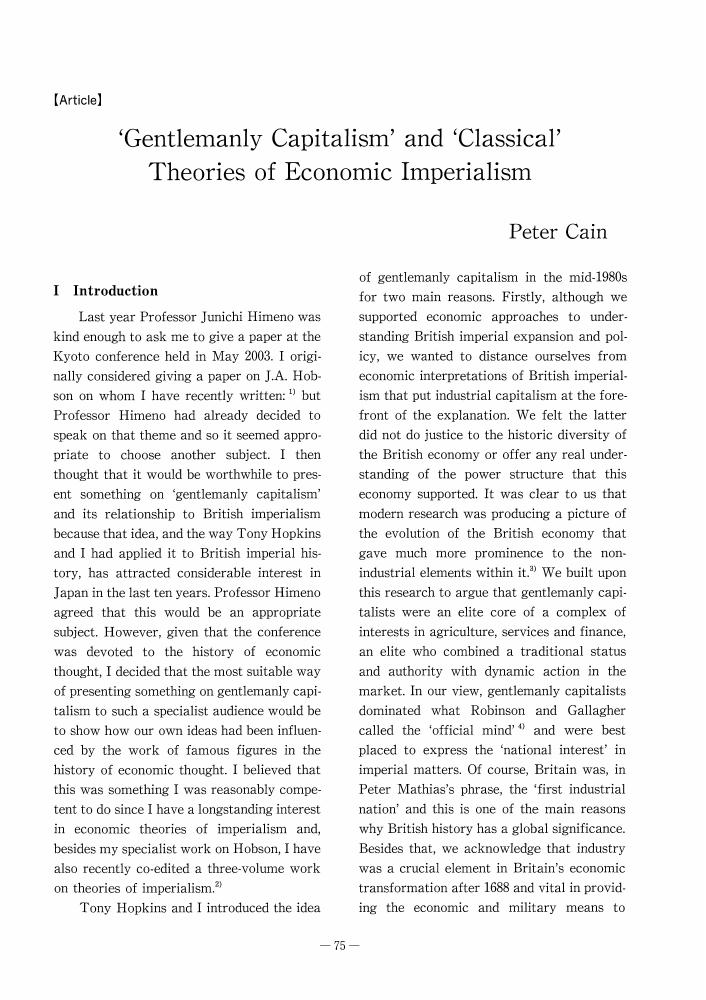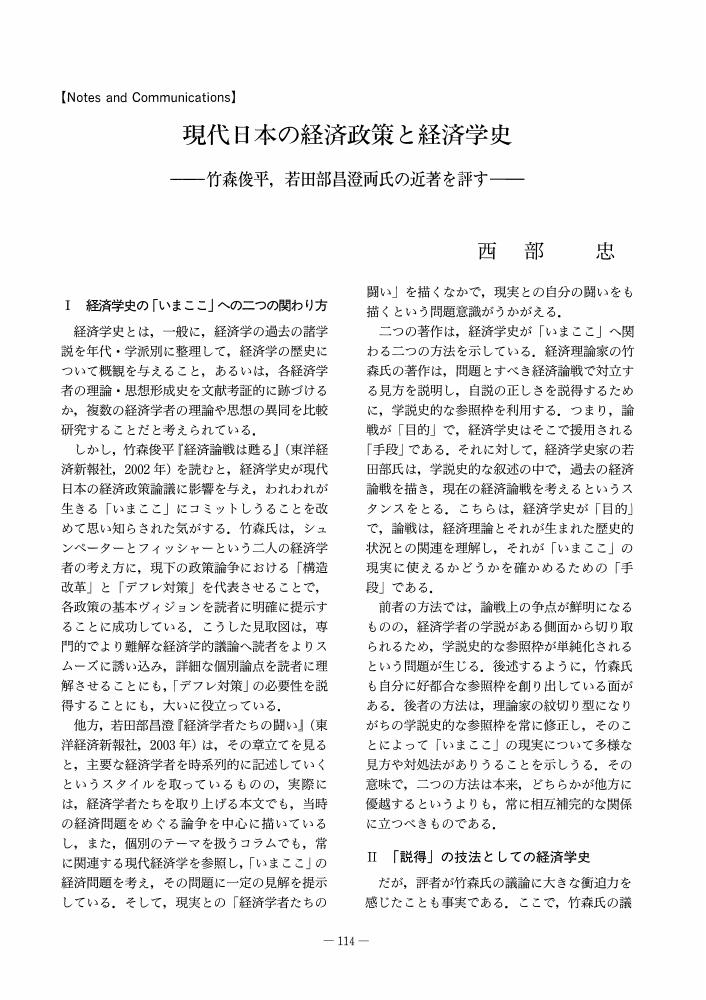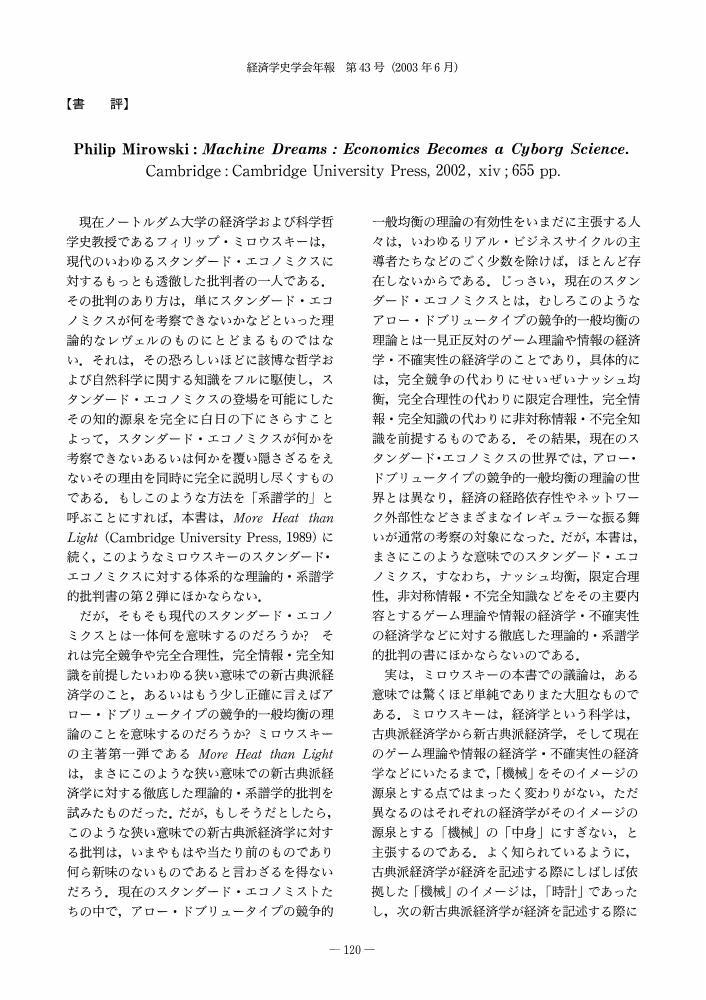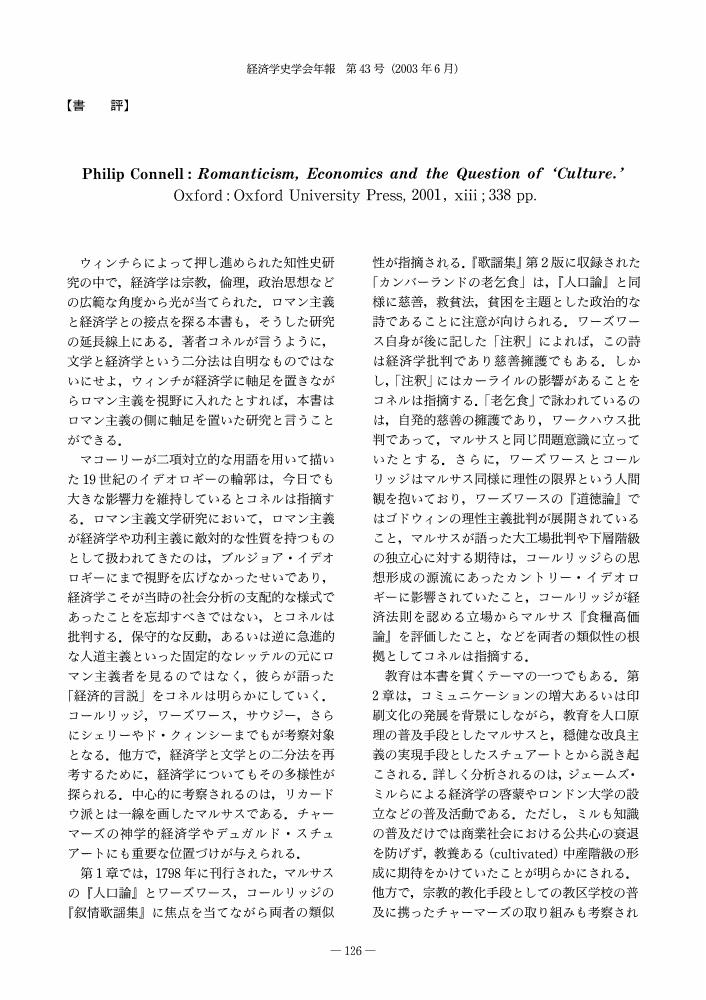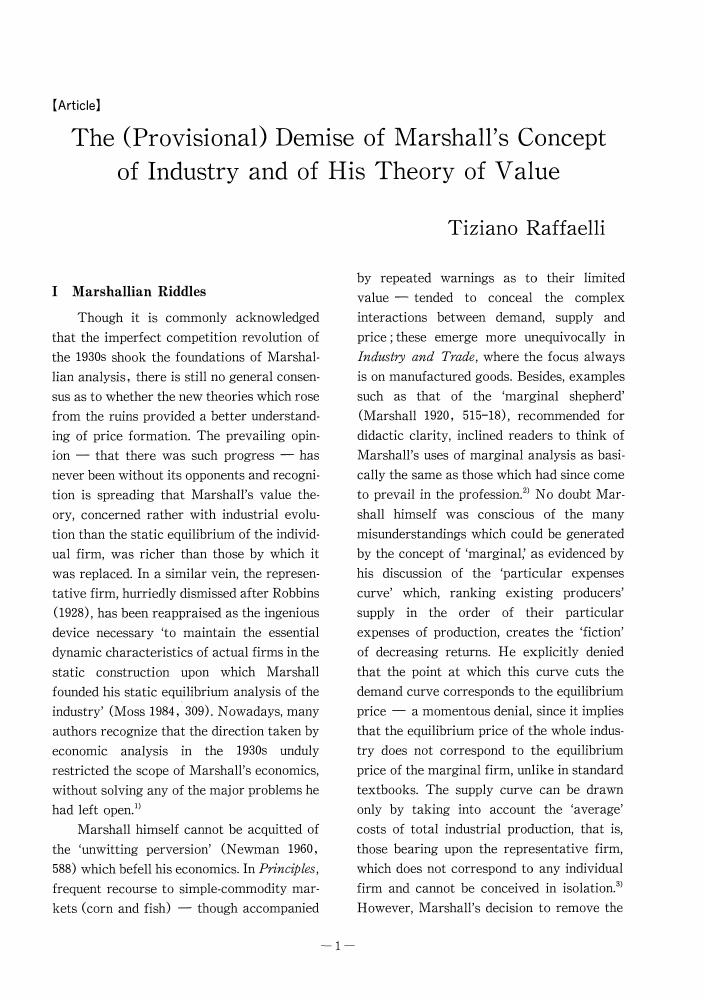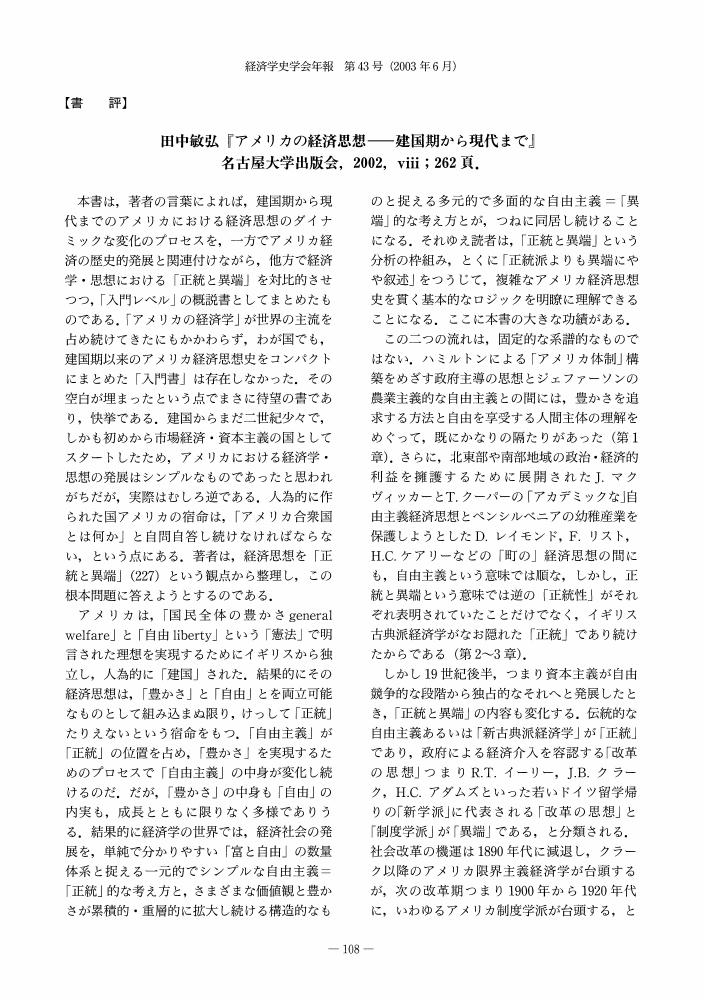- 著者
- Peter Cain
- 出版者
- The Japanese Society for the History of Economic Thought
- 雑誌
- 経済学史学会年報 (ISSN:04534786)
- 巻号頁・発行日
- vol.44, no.44, pp.75-83, 2003 (Released:2010-08-05)
1 0 0 0 OA 日本経済思想史: 経済政策思想と経済構想
- 著者
- 三島 憲之
- 出版者
- The Japanese Society for the History of Economic Thought
- 雑誌
- 経済学史学会年報 (ISSN:04534786)
- 巻号頁・発行日
- vol.44, no.44, pp.84-97, 2003 (Released:2010-08-05)
- 参考文献数
- 68
The purpose of this paper is to consider the direction of the future investigation by way of a review of the studies of the economic thought in the Meiji Period in the last twenty years.By studying the economic thought in the Meiji Period, generally not only the economists but also the thinkers, the journalists, the statesmen, the bureaucrats, and the entrepreneurs are made the object. As well, in regard to topics in the study of the Japanese economic thought of the age following the Meiji Restoration, we find at present a general consensus. If it is limited to he Meiji Period, the topics can be summarized as the following three approaches. The firs are studies that examine the so-called “continuance and severance” between the idea which allowed the reception of the Western political economy, and the economic thought in the Edo Period. The second are studies that intend to clarify the introduction of the Western political economy into Japan. The third are studies that aim to elucidate the process of the diffusion and the fixation of the Western political economy in Japan. In this paper, the first is called “the approach focusing on continuance and severance, ” the second is called “the approach focusing on the history of the introduction, ” while the third is called “the approach focusing on institutionalization.”In addition to those studies pursuing the above three lines of thought, there are studies that examine the economic policy ideas and the economic vision in the Meiji Period. This is called the “approach focusing on the history of the economic policy ideas.” This paper emphasizes the importance of the studies taking this point of view.Two ideas are fairly suggestive in the study talking the latter approach. One is “developmentalism.” This principle focuses on the nationalism of a backward country, industrialization under the governmental leadership, and the affirmation of governmental intervention in an economy. This can provide a conceptual framework for further study because its elements were widely contained in various economic policy ideas and economic visions appearing in the Meiji Period. The other one is the result of the more recent studies regarding the mercantilism. The authors of such studies insist on the following: Most political economy is structured in such a way that government can intervene to any degree in the market from the viewpoint of the public utility. And, free trade and protectionism often complement each other. If this view is accurate, the validity of the simple point of view in which free trade and protectionism confront each other must be reconsidered, this being true in the studies of the economic thought in the Meiji Period as well.
1 0 0 0 OA 古典派貨幣理論
- 著者
- 佐藤 有史
- 出版者
- The Japanese Society for the History of Economic Thought
- 雑誌
- 経済学史学会年報 (ISSN:04534786)
- 巻号頁・発行日
- vol.44, no.44, pp.98-113, 2003 (Released:2010-08-05)
- 参考文献数
- 76
Since late 1970's there has emerged a variety of ‘new’ interpretations of classical monetary theory, shedding new light on classical economists pace ‘old’ interpretations. They have indeed transformed our understanding of classical theory. Though there have already been several efforts to outline these ‘new’ interpretations: e. g., those of J. Niehans, M. C. Marcuzzo, A. Rosselli, N. T. Skaggs, and D. Glasner, they are far from monolithic, and indeed there are significant differences among their viewpoints. Unfortunately there has been no effort to comprehend ‘new’ interpretations, though several common grounds have been put forward to revise our understanding of classical theory as opposed to ‘old’ interpretations. It is time to synthesize and appraise the major findings of ‘new’ interpretations.In this review article I propose my own syntheses of ‘new’ interpretations as follows: (a) the theoretical framework of classical monetary theory was quite different from that of the quantity theory of money, while ‘old’ interpretations have often confused them, (b) classical economists had in fact developed a remarkable theory of monetary policy, while ‘old’ interpretations have failed to appreciate it since they have insisted in looking at classics through the ‘rules versus discretion’ lens, and (c) instead, the ‘central banking versus free banking’ controversy should be understood as one of the most crucial themes in appreciating the way in which classical economists sought to develop their own theories of money and banking, while almost all ‘old’ interpretations have neglected this aspect.Almost all the ‘new’ interpretations, including my own, have shared a broad agreement regarding thesis (a), though there are some differences, for example, regarding their attitudes to the monetary approach to the balance of payments, and its applicability to Adam Smith and David Ricardo. As for (b) and (c), there are differences, to which the modern free banking school has contributed. On the one hand, the modern free banking school, by highlighting the classical theory of commodity money, praises the Smithian-banking school tradition in favor of their case for free banking. In so doing, they put both Henry Thornton and Ricardo in a rather unhappy position. On the other hand, in their perceptive treatments of Ricardo's theory of money and monetary policy, Marcuzzo and Rosselli, and A. Arnon detect a rupture between Smith and the ‘true classical monetary theory’ of Thornton and/or Ricardo. I emphasize a continuity in the development of the classical theory of central banking from Smith to Ricardo via Thornton in that Smith played an important role in making the 1765 Act, banning small notes below f5 and optional clauses, which facilitated the Bank of England in his day to behave in the manner of a central bank. Moreover, it is Ricardo's plans both for ‘bullion payments’ and for the establishment of a national bank, a remarkable achievement of the classical theory of monetary policy, that makes the ‘old’ interpretations based on the ‘rules versus discretion’ distinction obsolete. I argue that there existed quite a coherent classical central banking tradition based on their insights into the fractional reserve banking system under the gold standard, rather than an alleged rupture between Smith and Thornton-Ricardo. I also emphasize that advocates for free banking in the classical era were in fact no match for the Smith-Thornton-Ricardo tradition.
1 0 0 0 OA 現代日本の経済政策と経済学史 竹森俊平, 若田部昌澄両氏の近著を評す
- 著者
- 西部 忠
- 出版者
- 経済学史学会
- 雑誌
- 経済学史学会年報 (ISSN:04534786)
- 巻号頁・発行日
- vol.44, no.44, pp.114-117, 2003 (Released:2010-08-05)
1 0 0 0 OA 「『重商主義再考』に対する3つのコメント」へのリジョインダー
- 著者
- 大森 郁夫
- 出版者
- 経済学史学会
- 雑誌
- 経済学史学会年報 (ISSN:04534786)
- 巻号頁・発行日
- vol.44, no.44, pp.118-120, 2003 (Released:2010-08-05)
- 著者
- 荒川 章義
- 出版者
- The Japanese Society for the History of Economic Thought
- 雑誌
- 経済学史学会年報 (ISSN:04534786)
- 巻号頁・発行日
- vol.43, no.43, pp.120-121, 2003 (Released:2010-08-05)
- 著者
- 鍋島 直樹
- 出版者
- The Japanese Society for the History of Economic Thought
- 雑誌
- 経済学史学会年報 (ISSN:04534786)
- 巻号頁・発行日
- vol.43, no.43, pp.122-123, 2003 (Released:2010-08-05)
- 著者
- 内山 隆司
- 出版者
- The Japanese Society for the History of Economic Thought
- 雑誌
- 経済学史学会年報 (ISSN:04534786)
- 巻号頁・発行日
- vol.43, no.43, pp.124-125, 2003 (Released:2010-08-05)
- 著者
- 柳沢 哲哉
- 出版者
- The Japanese Society for the History of Economic Thought
- 雑誌
- 経済学史学会年報 (ISSN:04534786)
- 巻号頁・発行日
- vol.43, no.43, pp.126-127, 2003 (Released:2010-08-05)
1 0 0 0 OA 『重商主義再考』に対する3つのコメント
- 著者
- 深貝 保則
- 出版者
- The Japanese Society for the History of Economic Thought
- 雑誌
- 経済学史学会年報 (ISSN:04534786)
- 巻号頁・発行日
- vol.43, no.43, pp.128-131, 2003 (Released:2010-08-05)
- 参考文献数
- 8
1 0 0 0 OA 『重商主義再考』に対する3つのコメント
- 著者
- 田中 秀夫
- 出版者
- The Japanese Society for the History of Economic Thought
- 雑誌
- 経済学史学会年報 (ISSN:04534786)
- 巻号頁・発行日
- vol.43, no.43, pp.131-133, 2003 (Released:2010-08-05)
- 参考文献数
- 1
1 0 0 0 OA 『重商主義再考』に対する3つのコメント
- 著者
- 柳澤 治
- 出版者
- The Japanese Society for the History of Economic Thought
- 雑誌
- 経済学史学会年報 (ISSN:04534786)
- 巻号頁・発行日
- vol.43, no.43, pp.133-137, 2003 (Released:2010-08-05)
- 参考文献数
- 5
- 著者
- Chikako Nakayama
- 出版者
- The Japanese Society for the History of Economic Thought
- 雑誌
- 経済学史学会年報 (ISSN:04534786)
- 巻号頁・発行日
- vol.43, no.43, pp.138-140, 2003 (Released:2010-08-05)
- 参考文献数
- 5
- 著者
- Tiziano Raffaelli
- 出版者
- The Japanese Society for the History of Economic Thought
- 雑誌
- 経済学史学会年報 (ISSN:04534786)
- 巻号頁・発行日
- vol.44, no.44, pp.1-16, 2003 (Released:2010-08-05)
- 参考文献数
- 70
1 0 0 0 OA 竹本洋・大森郁夫編著『重商主義再考』日本経済評論社, 2002, iv; 306頁
- 著者
- 大黒 弘慈
- 出版者
- 経済学史学会
- 雑誌
- 経済学史学会年報 (ISSN:04534786)
- 巻号頁・発行日
- vol.43, no.43, pp.104-105, 2003 (Released:2010-08-05)
1 0 0 0 OA 原田哲史『アダム・ミュラー研究』ミネルヴァ書房, 2002, xxi; 354; 15頁
- 著者
- 田村 信一
- 出版者
- 経済学史学会
- 雑誌
- 経済学史学会年報 (ISSN:04534786)
- 巻号頁・発行日
- vol.43, no.43, pp.106-107, 2003 (Released:2010-08-05)
- 著者
- 高 哲男
- 出版者
- 経済学史学会
- 雑誌
- 経済学史学会年報 (ISSN:04534786)
- 巻号頁・発行日
- vol.43, no.43, pp.108-109, 2003 (Released:2010-08-05)
- 著者
- 新村 聡
- 出版者
- 経済学史学会
- 雑誌
- 経済学史学会年報 (ISSN:04534786)
- 巻号頁・発行日
- vol.43, no.43, pp.110-111, 2003 (Released:2010-08-05)
1 0 0 0 OA 塩野谷祐一『経済と倫理-福祉国家の哲学』東京大学出版会, 2002, ix; 444頁
- 著者
- 有江 大介
- 出版者
- 経済学史学会
- 雑誌
- 経済学史学会年報 (ISSN:04534786)
- 巻号頁・発行日
- vol.43, no.43, pp.112-113, 2003 (Released:2010-08-05)
- 著者
- 堂目 卓生
- 出版者
- The Japanese Society for the History of Economic Thought
- 雑誌
- 経済学史学会年報 (ISSN:04534786)
- 巻号頁・発行日
- vol.43, no.43, pp.116-117, 2003 (Released:2010-08-05)
